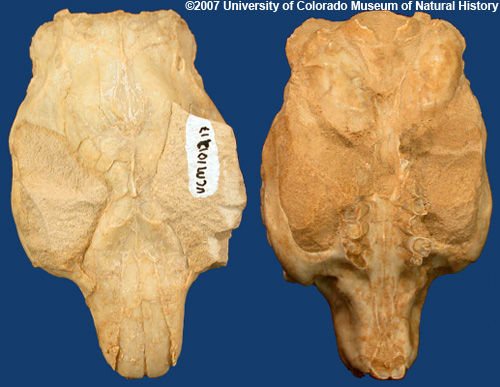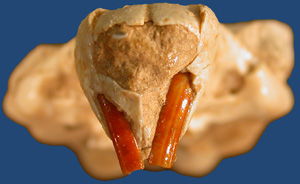OBJECT OF THE MONTH - SEPTEMBER 2007
A giant mouse (Ischyromys)

This example of Ischyromys, UCM 101217, from Niobrara County in western Nebraska was donated by Dorothy J. Stauber in April 2006. The skull is 2.75 inches (7cm) long, 1.75 inches (4.3cm) wide and 1 inch (2.5cm) tall. Left: top view; right, bottom view.
When you think of mice, you probably think of the pet you had as a child or the unwelcome guests who nibble through the boxes in your garage. But imagine big mice. Imagine huge mice. Imagine mice as big as squirrels!
About 33 million years ago, during the Early Oligocene epoch, the rodent Ischyromys (ish-ee-ROH-mees) inhabited central North America. These ancient rodents grew to about two feet (over half a meter) in length, and resembled large mice in appearance, but probably lived in trees like squirrels do today. While they are considered among the more primitive rodents, Ischyromys had large front teeth (called incisors) like the rodents we are familiar with today. Ischyromys is the most common Early Oligocene fossil rodent found in South Dakota, Nebraska, Wyoming and Colorado. It has also been found as far north as Saskatchewan, Canada and as far south as Texas.

Close up image of this Ischyromys specimen showing a frontal view of its large incisors.
Ischyromys went extinct around 25 million years ago. The only living relative is the distantly related mountain beaver (Aplodontia rufa), a small rodent that now lives along the west coast of North America.
The University of Colorado Museum of Natural History's Fossil Vertebrate Collection has over 500 fossils of Ischyromys. Most are teeth and pieces of jaws because these are the most likely to stand the test of time and become a fossil. The collection also has five complete or nearly complete skulls. These specimens have been used by researchers at the University of Colorado and other institutions to investigate various relationships among Ischyromys and closely-related animals and their distributions through space and time.


